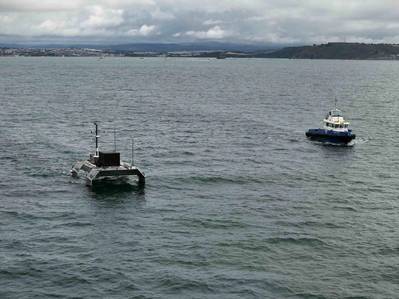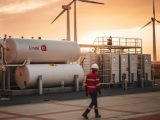
Hydrogen Fuel Cells Drive ACUA Ocean’s World-First 24-Hour Autonomous USV Trial
August 25, 2025We just watched hydrogen fuel cells tackle one of shipping’s biggest gauntlets—remote, round-the-clock offshore ops—and they came out unscathed.
ACUA Ocean launched its Pioneer USV from Turnchapel Wharf in Plymouth. Twelve nautical miles later it slipped past the Eddystone Lighthouse in the English Channel, wrapping up a full 24-hour mission with zero emissions. If you need proof that zero-emission technology can handle the high seas, this is it.
Key Facts
- 24-hour USV run off Plymouth, Devon.
- 12-nautical-mile jaunt from Turnchapel Wharf to Eddystone Lighthouse.
- Powered entirely by hydrogen fuel cells—zero GHG at point of use.
- Certified under the UK MCA’s Workboat Code Edition 3 Annex 2.
- Stamped by Lloyd’s Register in December 2023.
- Data-crunching duo: University of Southampton & MarRI-UK.
- Built by Aluminium Marine Consultants, designed by John Kecsmar.
- Supports the UK’s Clean Maritime Demonstrator Competition goals.
Technical Spotlight
You don’t need a PhD in rocket science to get this. The Pioneer tucks compressed hydrogen onboard, feeding an electrochemical powerhouse that mashes H₂ and O₂ into electricity, water, and heat. Those electrons zip over to electric motors, delivering whisper-quiet, smooth-as-glass thrust. No smoke. No soot. Just water vapour—and maybe a few seagull cheers.
At its core sits a proton exchange membrane (PEM) fuel cell stack—think efficiency meets tank-like toughness (essential when waves are tossing deck gear like toothpicks). Sensors and smart software juggle temperature, pressure, and power output, while a backup battery soaks up any spikes. And it’s modular: slot in a beefier stack or cram in more H₂ to stretch your endurance even further.
Regulatory Breakthrough
This wasn’t just another tech demo—it rode shotgun on a regulatory first. In December 2023, the UK Maritime and Coastguard Agency (MCA) gave Pioneer the green light under its new Workboat Code Edition 3 Annex 2, making it the world’s first certified remotely operated, hydrogen-powered vessel. Lloyd’s Register put its stamp on it, proving that “autonomy” and “safety” can play nice under strict UK regs.
That nod doesn’t just tick a box—it rewrites the rulebook. Until now, shipping had zero framework for unmanned, zero-emission craft. Welcome to the new era of hydrogen infrastructure and global regulatory convergence.
Operational Profile
Pioneer isn’t a pond toy. It squared off against English Channel favorites: choppy swells, shifting currents, and busy traffic lanes. A shore team in Devonport tracked every move—position, speed, system vitals—via satellite. Onboard, radar, LiDAR, AIS, GPS, and cameras teamed up to dodge vessels and obstacles, with human operators jumping in remotely only at major waypoints.
By the numbers: cruising speed sat around 4 knots, spiking to 6 knots when the sea smiled. Energy use matched pre-trial forecasts to the letter, proving hydrogen’s predictability. No refuel hiccups. No alarms. Just uninterrupted, reliable service.
Industry Context
Here’s the kicker: global shipping still runs mostly on fossil fuels, accounting for about 3% of annual GHG emissions. Roadmaps for industrial decarbonization have long flirted with batteries for short hops and LNG as a stopgap. But hydrogen fuel cells serve up range, fast refuels, and zero local emissions—and autonomy slashes crew costs and risk.
The UK’s Clean Maritime Demonstrator Competition has pumped hundreds of millions into projects like this. The mission? Cement Britain’s edge in sustainable energy shipping tech. ACUA Ocean just nailed the headlines—hydrogen, autonomy, certification, real-world mission. It’s a masterclass in policy and industry working hand-in-hand.
Strategic Angle
Let’s talk numbers. Offshore wind farms, subsea inspections, ocean-science surveys—they all need reliable, low-carbon vessels. Crewed charters can run €5,000–€15,000 a day. Ditch the crew, slash fuel bills, and you’re staring at 30–50% OpEx cuts. That’s ROI that catches your eye.
Meanwhile, hydrogen bunkering hubs in ports like Aberdeen, Teesport, and Plymouth are scaling up fast. Incentives—from H₃ Sail to the EU’s Fit for 55—are opening wallets. If you’re in shipping and not piloting a clean vessel, you’re already a wave behind.
Analyst’s Take
Don’t get me wrong—challenges remain. Most hydrogen still comes gray or blue, and fuel cell capex is steep. But the Pioneer trial flips the narrative: instead of boardroom debates, we’ve got lab-grade data on rolling seas. That’s the shift from “maybe someday” to “coming soon.”
Expect prices to drop as electrolyzer capacity grows and supply chains tighten. Watch regulators worldwide follow suit on standards. Once that first domino falls, brace for a hydrogen build-out boom. If you thought the battery-electric sprint was intense, wait until hydrogen and autonomy collide.
So, what’s next? Will we soon be booking crew-free, zero-emission charters? I’d put money on it. Ready to bid farewell to diesel fumes and hello to triumphant seagull applause? The future just docked in Plymouth.



 With over 15 years of reporting hydrogen news, we are your premier source for the latest updates and insights in hydrogen and renewable energy.
With over 15 years of reporting hydrogen news, we are your premier source for the latest updates and insights in hydrogen and renewable energy.